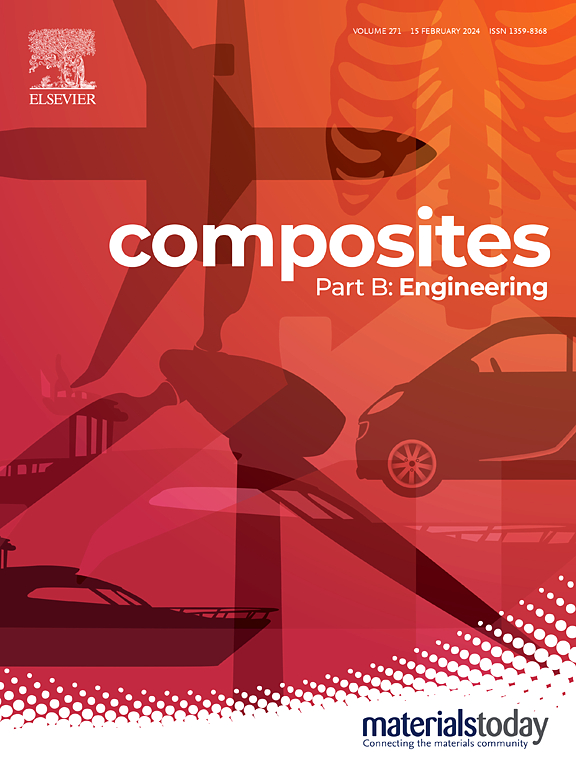Sandwich-structured paper composite with water and oil resistance for food packaging and tableware applications
IF 14.2
1区 材料科学
Q1 ENGINEERING, MULTIDISCIPLINARY
引用次数: 0
Abstract
The growing environmental challenges posed by plastic waste from disposable tableware highlight the urgent need for sustainable alternatives. Traditional plastics decompose over centuries, generating microplastics that threaten ecosystems and human health. While lignin has emerged as a promising material for plastic replacement, its inherent dark brown color and processing challenges in paper-based products have limited its application, particularly in food-contact materials. To address these limitations, we have developed biodegradable sandwich-structured paper composites comprising parchment paper as surface layers and a lignin-polymer core with polyvinyl alcohol (PVA) and polylactic acid (PLA). This innovative structure eliminates the need for binders, minimizing potential food contamination, and enables direct application as packaging or molded tableware. Lignin micro- and nano-particles (LMNP) enhances durability and provides natural water and oil resistance without harmful additives, such as per- and polyfluoroalkyl substances (PFAS), while PVA and PLA improve the composite's tenacity. The resulting material, composed of 65 wt% lignin, demonstrates excellent water and oil resistance, with no penetration exceeding 1 h, and exhibits enhanced tensile strength (45 MPa), making it a viable and eco-friendly alternative for disposable tableware.
耐水、耐油的三明治结构复合纸,用于食品包装和餐具
一次性餐具产生的塑料废物对环境造成的日益严峻的挑战凸显了对可持续替代品的迫切需求。传统塑料经过几个世纪的分解,产生了威胁生态系统和人类健康的微塑料。虽然木质素已成为一种很有前途的塑料替代品,但其固有的深棕色和纸基产品的加工挑战限制了其应用,特别是在与食品接触的材料中。为了解决这些限制,我们开发了可生物降解的三明治结构纸复合材料,包括羊皮纸作为表面层和木质素聚合物芯,聚乙烯醇(PVA)和聚乳酸(PLA)。这种创新的结构消除了对粘合剂的需求,最大限度地减少了潜在的食品污染,并可以直接应用于包装或模制餐具。木质素微纳米颗粒(LMNP)增强了耐久性,并提供天然的耐水性和耐油性,不含有害添加剂,如全氟烷基和多氟烷基物质(PFAS),而PVA和PLA提高了复合材料的韧性。由此产生的材料,由65%的木质素组成,具有优异的耐水性和耐油性,渗透不超过1小时,并表现出增强的抗拉强度(45 MPa),使其成为一次性餐具的可行和环保替代品。
本文章由计算机程序翻译,如有差异,请以英文原文为准。
求助全文
约1分钟内获得全文
求助全文
来源期刊

Composites Part B: Engineering
工程技术-材料科学:复合
CiteScore
24.40
自引率
11.50%
发文量
784
审稿时长
21 days
期刊介绍:
Composites Part B: Engineering is a journal that publishes impactful research of high quality on composite materials. This research is supported by fundamental mechanics and materials science and engineering approaches. The targeted research can cover a wide range of length scales, ranging from nano to micro and meso, and even to the full product and structure level. The journal specifically focuses on engineering applications that involve high performance composites. These applications can range from low volume and high cost to high volume and low cost composite development.
The main goal of the journal is to provide a platform for the prompt publication of original and high quality research. The emphasis is on design, development, modeling, validation, and manufacturing of engineering details and concepts. The journal welcomes both basic research papers and proposals for review articles. Authors are encouraged to address challenges across various application areas. These areas include, but are not limited to, aerospace, automotive, and other surface transportation. The journal also covers energy-related applications, with a focus on renewable energy. Other application areas include infrastructure, off-shore and maritime projects, health care technology, and recreational products.
 求助内容:
求助内容: 应助结果提醒方式:
应助结果提醒方式:


